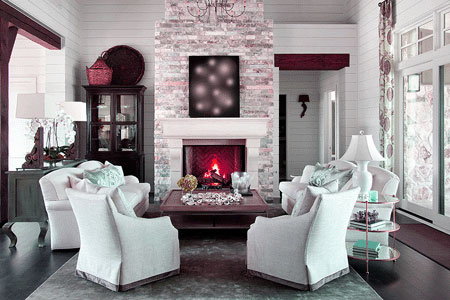
Learning to set an interior focal point is one of the most important skills possessed by any home stager. Without proper focal points, any room will feel smaller, less useful and disjointed, since the space will not have a specific center to define beauty or functionality.
Focal points are defined as specific features of a room that demand attention. These are the décor attributes that get noticed almost universally upon entry into any new space. A focal point must command attention; subtly or obviously. Virtually any feature can be the focal point of any room. This makes choosing the right center-point a rather subjective endeavor that is best left for a design expert. Choosing the wrong focal point can have worse aesthetic consequences than not highlighting any focus at all.
This guide details the concept of focal points and explains how to select the area of the room which deserves to be the center of all attention.
Defining an Interior Focal Point
The definition of a focal point is a design feature that will be noticed above all others. Virtually any attribute or fixture of a room can act as a center-point, when properly staged. A focal point does not have to be in the middle of the room, and in fact, it does not even have to be inside the room itself. A perfect example of the latter statement is a beautiful scenic view that happens to be the star of the show, even though it exists outside the defined space.
Focal points can be obvious or subtle, but should exist in virtually every room. Focal points create mental pictures of each space, helping to endear buyers to every room, while simultaneously defining the usefulness of each space. Therefore, the first lesson in choosing a focal point is to select an area or item that reflects the function of the space, works within the overall design of the entire home and still has enough unique appeal to develop a memory connection to the specific room.
I know that this sounds a bit complicated from a layman’s point of view, but it really is not that difficult, once you get some practice.
Choosing a Focal Point
Remember to begin your quest for the perfect center-point by contemplating the functionality of the room. Then, choose the item or location that is most crucial to communicate this use to prospective buyers. Below are listed some super-simple examples of choosing a perfect center-point for a given room:
Bedrooms must embody restful tranquility. Therefore, in virtually every case, the bed should be the focal point. Dress it to impress.
Dining rooms should call to mind warm time spent with family and friends, sharing food and drink together. Therefore, the table and chairs must hold the most important position in the room. Make them stars in the room.
Media rooms should be dominated by the screen, in order to call attention to the show that is about to begin.
Living rooms should concentrate their focus on the areas of conversation. The actual focal point can be a furniture grouping, a fireplace or even a crucial architectural detail.
There are rarely absolute rules for creating focal points in a room and each space should be evaluated individually to ascertain the best focal center for any interior application.
Interior Focal Point in Design
Setting a single focal point is rather easy, even for novices. However, what about the idea of setting more than one focal point in a room? Is this possible or even advised? Of course. Many rooms will have multiple focal points. Large spaces will benefit from many focal areas, in order to remind buyers of the true scale of the interior space. Great rooms and multipurpose rooms will require several focal points in order to truly embody their usefulness.
Obviously, creating a beautiful multiple center-point design can become quite complex. This is why it is always a great idea to hire a professional home stager or home stylist when you need assistance. Even if you want to perform DIY work, by staging or decorating your own home, retaining the services of a staging consultant will provide idyllic design ideas that are unlikely to ever be possible without some expert help.
In summary, trial and error is always a good way to improve your skills in any aspect of design. Try things out. You can always change your mind. Ask your real estate agent for their opinion if you insist on doing all the work by yourself. They will have enough of a trained eye to get you on the right path in most cases. If you need more help, feel free to contact me anytime.




